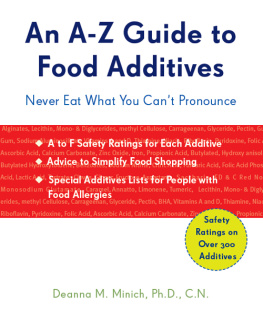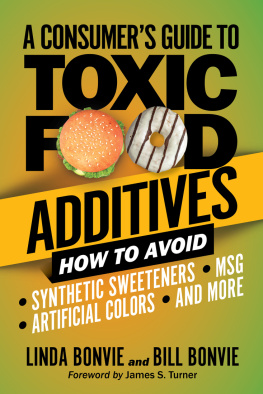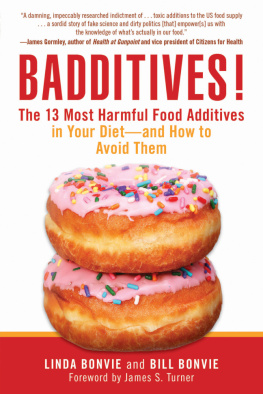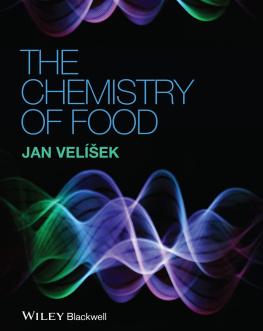
First published in 2009 by Conari Press,
an imprint of Red Wheel/Weiser, LLC
With offices at:
500 Third Street, Suite 230
San Francisco, CA 94107
www.redwheelweiser.com
Copyright 2009 by Deanna M. Minich, Ph.D., C.N.
All rights reserved. No part of this publication may be reproduced or transmitted in any form or by any means, electronic or mechanical, including photocopying, recording, or by any information storage and retrieval system, without permission in writing from Red Wheel/Weiser, LLC. Reviewers may quote brief passages.
ISBN: 978-1-57324-403-9
Library of Congress Cataloging-in-Publication Data available upon request.
Cover and interior design by Maija Tollefson
Typeset in Scala and Officina
Printed in Canada
TCP
10 9 8 7 6 5 4 3 2 1
The paper used in this publication meets the minimum requirements of the American National Standard for Information SciencesPermanence of Paper for Printed Library Materials Z39.48-1992 (R1997).
www.redwheelweiser.com
www.redwheelweiser.com/newsletter
To my sister, Brenda, and to all those who need assistance in finding their way among the massive explosion of processed foods in this age of fast living
Contents
Acknowledgments
Thanks to my mother, I was probably one of the few nine-year-olds in the 1970s who could read nutrition labels. After all, it isn't often that children are taught to understand words like mono- and di-glycerides and BHT. Her brilliant insight and earnest quest for knowledge about the food supply started me down the path I walk todaysharing nutritional information with others is now my life's mission. My passion has been funneled into ensuring that people have the knowledge they need about foods to become and keep healthy. As I was writing this book and telling others about it, I was met with an overwhelming response to the idea of having this resource available. People are hungry for guidance on understanding the complicated food supplyI thank all of you for being the truth-seekers and continually questioning the quality of the foods you eat!
In my life, there have also been a number of other teachers and mentors who have passed on their nutritional pearls to whom I express heartfelt gratitude: Phyllis Bowen, Maria Sapuntzakis, Henkjan Verkade, Roel Vonk, Barb Schiltz, and Jeffrey Bland.
My sincere thanks go to my amazing agent, Krista Goering, whose heart is embedded in the work of bringing health information to others. I couldn't ask for a more skilled, compassionate editor than Caroline Pincus, who has been an absolute delight to work with on this and other book projects. And, finally, I thank Mark and my three furry friends for their patience and support in the creation of this book.
Disclaimer
This book contains, to the best of the author's ability, accurate and current information, but it is not a comprehensive guide to all chemicals that exist in the food supply. The author and the publisher do not assume any liability for ways in which the information presented in the text is applied or interpreted, or for any loss, damage, or injury incurred by relying on information contained herein. This book is not intended to be a substitute for medical counseling and supervision, and is not for the purpose of diagnosing, treating, curing or preventing any disease. Please see a qualified health-care professional if you need medical advice.
Introduction
If you can't pronounce it, don't buy it.
Elson M. Haas, MD, author of Staying Healthy with Nutrition
Don't eat anything your great grandmother wouldn't recognize as food.
Michael Pollan, author of In Defense of Food
Our modern society has birthed a new language: Food Additive-ese. Unless you're a nutritionist, food technologist, or chemist, chances are you don't understand much of the new jargon, but you're immersed in it every time you go to a grocery store. Store shelves are laden with thousands of words waiting to be deciphered, and hundreds of new ones are piled on every year. This language, spoken on volumes of food labels, is speckled with infamous unpronounceableslong, polysyllabic, knotty, chemical-ized names of additives that have made their way into our everyday eating. Trying to speak this language is like talking with a mouthful of marblesyour speech becomes garbled and you end up spitting the word out with a winced face, accompanied by a shot of embarrassment and slight giggle.
To make life easier, food additives are now disguised with code names. Instead of tongue-tripping over their chemical names, you can now spout out their perky, friendly acronyms or brand namesBHA rather than butylated hydroxyanisole and aspartame in place of aspartyl-phenylalanine-1-methyl ester. The complexity of the language and the hoops you need to jump through to translate its vocabulary make knowing what you are truly eating a tenuous venture.
Although food additives are often used in small amounts, these minute amounts add up. The average American consumes about 150 pounds of food additives a year, the bulk of it sugar and sweeteners, followed by salt, vitamins, flavors, colorings, and preservatives, representing almost 10 percent of the food we eat each year. To make choices you feel good about, you need an additive translator to help make sense of it all. With this book as a personal guide, you will be able to tiptoe through the field of additive landmines and ingredients that may cause allergic reactions like headaches, fatigue, and breathing difficulties, or those that cause you to get bloated or feel hyperactive.
The average American consumes about 150 pounds of food additives a year, the bulk of it sugar and sweeteners, followed by salt, vitamins, flavors, colorings, and preservatives, representing almost 10 percent of the food we eat each year.
But let's back up a moment. While in the trenches at the supermarket, have you ever stopped mid-aisle to question how the food supply came to be complicated and convoluted to the point that you need an expert to tell you what to eat? Why should you need a book like this just to understand your every bite?
If we observe from a distance, we uncover a possible answer in our everyday frenzy. Day-to-day routines have become just a bit crazier, packed with extended working hours and overflowing with responsibilities. Our eyes and ears are bombarded with continuous, mind-numbing sound-bytes delivered by e-mail, radio, and TV. Technological advances are multiplying, renewing the flow of information every couple of hours. The only way to survive and succeed is to simplify. Nowadays, if we can't say something in six words or eat something in six bites, we may not be able to give it our undivided attention. One of the ways we have achieved our quest for convenience is at the expense of our nourishment. Packaged, ready-toeat foods allow us to squeeze it all into be nothing less than superhuman. In return for handy prepackaged edibles, we now need to learn labelese to make sense of it all. Ironic isn't it? We try our best to save time with convenient foods, but then spend extra time just learning what we are eating.
Thanks to food additives, packaged items can now sit on the shelves for years and be ready to eat whenever you are, if you have the patience to break through the casings of cardboard, Styrofoam, metal, and plastic. Additives give foods an internal makeover by improving their flavor and appearance and replacing nutrients lost in processing. Technically, they are defined by the Federal Food, Drug, and Cosmetic Act set forth by the U.S. Food and Drug Administration (FDA) as any substance which becomes a part of the food matrix as a result of producing, manufacturing, packing, processing, preparing, treating, packaging, transporting, or holding food; and including any source of radiation intended for any such use. With the average food traveling 1500 miles or more to your dinner table, you can only imagine the mosaic of food additives that have become a part of what you are eating.
Next page









